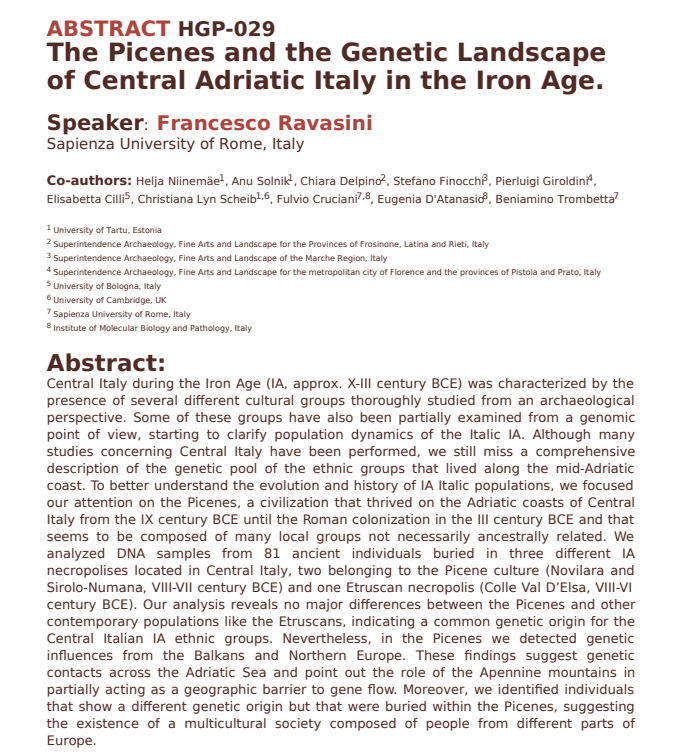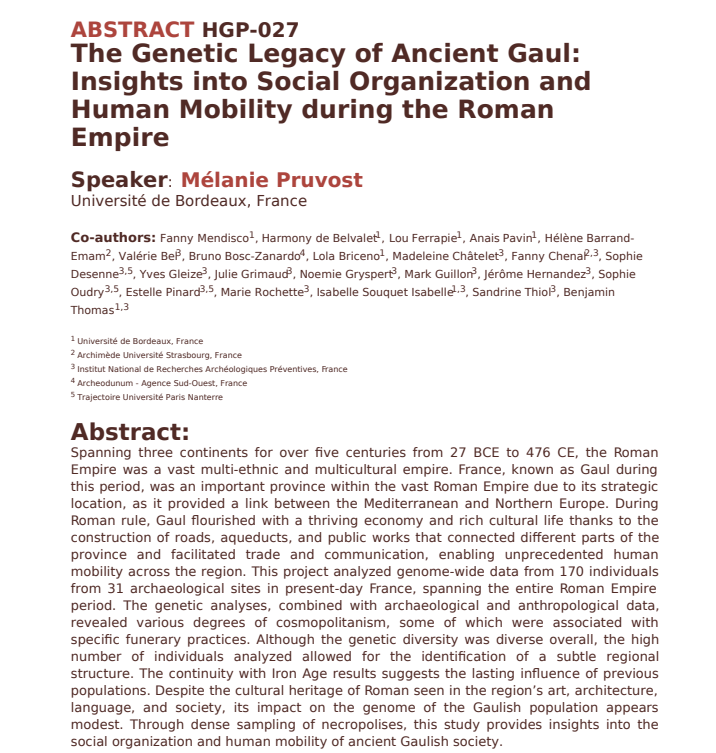The Genetic Legacy of Ancient Gaul: Insights into Social Organization and Human Mobility during the Roman Empire
Page 226
 drive.google.com
drive.google.com

The abstract describes a research project that aimed to explore the genetic legacy of ancient Gaul, which was a significant province in the Roman Empire. The study focuses on understanding the social organization and human mobility in Gaul during the Roman period by analyzing genome-wide data from 170 individuals across 31 archaeological sites in modern-day France.
This data is also correlated with archaeological and anthropological evidence to provide a multi-dimensional view of ancient Gaulish society.
Key Points:
Context: The Roman Empire was vast, multi-ethnic, and multicultural, lasting from 27 BCE to 476 CE. Gaul (now France) was a strategically important province in the empire, serving as a link between the Mediterranean and Northern Europe.
1. Human Mobility and Infrastructure: The study acknowledges the construction of Roman roads, aqueducts, and public works that facilitated trade, communication, and human mobility in Gaul.
2. Genetic Diversity: Genetic analyses were performed on samples from 170 individuals, revealing a diverse genetic makeup. However, the number of samples allowed the researchers to identify subtle regional genetic structures within Gaul.
3. Cosmopolitanism and Funerary Practices: The study found varying degrees of cosmopolitanism in different regions, with some being linked to specific funerary practices. This could potentially indicate different levels or types of interactions with other cultures or populations.
4. Continuity with Iron Age: Despite Roman rule and influence, the genetic makeup of the population showed continuity with Iron Age populations, suggesting that the impact of Roman occupation was not as pronounced at the genetic level.
6. Cultural vs. Genetic Impact: The Roman cultural imprint is visible in art, architecture, language, and society in the region. However, the study suggests that this cultural influence did not significantly alter the genome of the Gaulish population.
7. Insight into Social Organization and Mobility: Through the analysis of genomes and by studying necropolises, the research provides new insights into the social organization and patterns of human mobility in ancient Gaul.
Implications
The study is significant because it offers a nuanced view of the impact of Roman rule in Gaul, contrasting the cultural and infrastructural changes with the more modest changes in the genetic makeup of the population. It highlights the complexity of human history, where cultural and genetic influences don't always move in lockstep. Moreover, by combining genetic data with archaeological and anthropological evidence, the study contributes to a more comprehensive understanding of ancient societies.
Page 226
ISBA10 Abstract Book.pdf
 drive.google.com
drive.google.com

The abstract describes a research project that aimed to explore the genetic legacy of ancient Gaul, which was a significant province in the Roman Empire. The study focuses on understanding the social organization and human mobility in Gaul during the Roman period by analyzing genome-wide data from 170 individuals across 31 archaeological sites in modern-day France.
This data is also correlated with archaeological and anthropological evidence to provide a multi-dimensional view of ancient Gaulish society.
Key Points:
Context: The Roman Empire was vast, multi-ethnic, and multicultural, lasting from 27 BCE to 476 CE. Gaul (now France) was a strategically important province in the empire, serving as a link between the Mediterranean and Northern Europe.
1. Human Mobility and Infrastructure: The study acknowledges the construction of Roman roads, aqueducts, and public works that facilitated trade, communication, and human mobility in Gaul.
2. Genetic Diversity: Genetic analyses were performed on samples from 170 individuals, revealing a diverse genetic makeup. However, the number of samples allowed the researchers to identify subtle regional genetic structures within Gaul.
3. Cosmopolitanism and Funerary Practices: The study found varying degrees of cosmopolitanism in different regions, with some being linked to specific funerary practices. This could potentially indicate different levels or types of interactions with other cultures or populations.
4. Continuity with Iron Age: Despite Roman rule and influence, the genetic makeup of the population showed continuity with Iron Age populations, suggesting that the impact of Roman occupation was not as pronounced at the genetic level.
6. Cultural vs. Genetic Impact: The Roman cultural imprint is visible in art, architecture, language, and society in the region. However, the study suggests that this cultural influence did not significantly alter the genome of the Gaulish population.
7. Insight into Social Organization and Mobility: Through the analysis of genomes and by studying necropolises, the research provides new insights into the social organization and patterns of human mobility in ancient Gaul.
Implications
The study is significant because it offers a nuanced view of the impact of Roman rule in Gaul, contrasting the cultural and infrastructural changes with the more modest changes in the genetic makeup of the population. It highlights the complexity of human history, where cultural and genetic influences don't always move in lockstep. Moreover, by combining genetic data with archaeological and anthropological evidence, the study contributes to a more comprehensive understanding of ancient societies.


